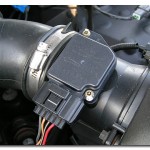Fuel Tech Experts Latest News and Articles

Mass Airflow Sensor (MAF) Cleaning & Cleaners
 by Andy Published on Friday, January 10th, 2014
by Andy Published on Friday, January 10th, 2014
A Mass Airflow Sensor (MAF) measures the amount of air entering an engine. It is important to measure air so the ECU can calculate the correct amount of fuel to inject into the combustion chamber to achieve the optimum air/fuel ratio. Because of the MAF’s important role, it should be attended to regularly, just as you would an air filter.
MAFs got their name because they are designed to calculate the entire mass of air rather than just the flow rate. This helps the ECU better respond to differences in air density from changes in temperature and air pressure. However, Air Intake Temperature (IAT) sensors and, in many cases, Mass Pressure (MAP) sensors are still required.
The most common MAF type is the hot wire. This pre-heated filament, when hit with air, cools and creates a change in electrical resistance. This subsequently changes the voltage signal (normally between 0 and 5 volts) sent to the ECU.
Over time, the hot wire on the sensor can accumulate debris, dust, and sometimes oil particulates, especially if an aftermarket filter or induction kit is fitted, as the filter is typically coated with an oil to trap fine dust. As a result, this oil and debris can make their way onto the sensor, affecting the accuracy of the airflow signal to the ECU. This can result in poor engine running, hesitation, increased emissions, reduced MPG, and so on.
Unfortunately, even the most modern ECUs cannot detect this degradation of performance. An error code or warning light will only appear if the unit has failed completely.
The solution is to clean the MAF at each service schedule with a designated MAF cleaner. Standard electrical contact cleaners are also effective, but ensure they do not leave any residue. Also, remember that they usually contain a single basic solvent. In contrast, professional MAF cleaners have a blend of multiple solvents specifically for the type of debris that needs to be removed, making the job a little easier.
We recommend Archoil AR2810 MAF Cleaner as it contains 300ml of the best solvents available for precisely this task. It also is completely safe for all MAF materials and plastics, leaves absolutely zero residues, and is comparable in cost to basic contact cleaners when considering the size of the can.
If you require any advice or help, please don’t hesitate to contact us and either I or a member of my team will be pleased to assist you.
8 thoughts on “Mass Airflow Sensor (MAF) Cleaning & Cleaners”
Leave a Reply
 categories
categories
- Air Intake Cleaning (1)
- Best Motor Oil (2)
- Biodiesel & Biofuels (2)
- Car Emissions (1)
- Carbon Cleaners (6)
- Cetane Boosters (1)
- DPF Cleaning & Maintenance (2)
- EGR Cleaning & Maintenance (2)
- Engine Cleaning (1)
- Engine Flush & Compression Restore (2)
- Engine Oils (2)
- Engine Tuning / Mapping & Tuning Boxes (2)
- Fleet & Commercial Solutions (1)
- Fuel Addtives (9)
- Fuel Quality (2)
- Fuel Saving (6)
- Fuel System Cleaning (8)
- Heating Oil Additives (1)
- Hybrids (1)
- Misfuelling Devices (1)
- Octane Boosters (2)
- Oil Additives (1)
- Pentosin (1)
- Race Fuel (1)
- Reducing Emissions (1)
- Smart O Plug (1)
- TFSI Direct Injection Carbon (1)
- Turbo Cleaning & Maintenance (1)
- Uncategorized (3)
- Waterless Engine Coolant (1)


Hi I have a1997 R/Rover 4.6 V8, today I hope to find out if the Maf sensor has had it for sure. My problem is what make to replace it with, I wonder if you could help, l have seen them for sixty pounds and one hundred & forty, I have looked for Sagem which looks to be the original, with no success, I will carry on looking.
Regards Pete
Stick to OEM with airflow sensors.
I have disconnected my MAF Sensor after an identified fault. My X-trail (2003) is now running well with only a slight loss of turbo boost. No faults are shown.
Is there any harm likely to be caused by me doing this?
Yes – potential engine damage. The ECU needs to know the volume of air in order to calculate the correct fueling.
Hi all,once my d3 gets warm it starts making a sucking sound or whoosh for a few seconds after de-celebration sometimes more prolonged up long hills or load, car power and performance are great but I think this air sucking sound shouldn’t be there, my friend is sure it’s coming from turbo, he thinks veins or actuator Rod sticking, but I get no smoke or error lights or codes etc. Hoses etc checked, gearbox had an overhaul as I was advised torque converter,doesn’t do it on the drive in neutral v v strange, someone suggested MAF sensor as it could be turbo overshoot…..help lol ?
Difficult to advise without listening to the vehicle. This could be due to a leak or just how excess pressure when coming off the turbo is being recirculated back into the intake. I am not familiar with the plumbing on that engine but I would check for a fault with the turbo recirc valve/system.
How much is the MAF cleaner from you guys please inc delivery??.
I await your responce.Thank you…..Kev.
Hi, it can be purchased here http://www.powerenhancer.co.uk/product.php?xProd=864.